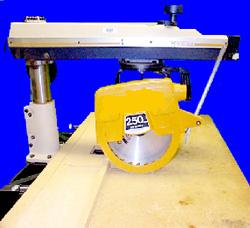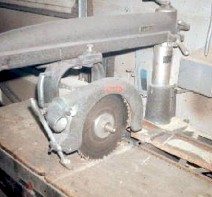Machine Guarding eTool
Saws » Radial Saws

Radial saws are circular saws that cut downward, either with or against the wood grain (rip or crosscut). Radial saws have features that make them more versatile than table saws. The saw arm can be raised and lowered and swung from side to side to adjust the depth and horizontal angle of the cut. The blade can also be replaced with shaping cutters, disks, or drum sanders and other accessories.
Operator Involvement
For crosscutting, the operator pushes the wood away from himself or herself against a fence. For rip cuts, the blade is set parallel to the fence, and the stock is pushed through. The saw blade rotates upward toward the operator, who feeds the stock in the opposite direction of the blade movement.

Potential Hazards
-
Contact with the turning blade may occur.
-
If the saw blade is able to go past the edge of the table, the blade could come in contact with the operator's body.
-
Material may move during cuts.
Solutions
-
Enclose the upper half of the saw (from the blade down to the end of the saw arbor) with a fixed hood. Guard the lower half with a self-adjusting, floating guard that rises and falls and automatically adjusts to the thickness of the stock. [29 CFR 1910.213(h)(1)]
-

Make sure the saw has a return device. The front end of the unit must be slightly higher than the rear, so that the cutting head will return to its original position when released by the operator. This must also prevent the cutting head from rolling or moving the arm due to gravity or vibration. [29 CFR 1910.213(h)(4)]
-
Install an adjustable stop to limit forward travel distance of the blade during repeat cuts. [29 CFR 1910.213(h)(3)]
-
Use limit chains or other effective means (for example, extend the table edge) to keep saw from moving beyond the front or back edge of the table. [29 CFR 1910.213(g)(3)]
Additional Safety Measures
-
Securely fasten material to avoid unwanted movement during cuts.
-
Measure boards against a stop gauge or turn off the saw if measuring by rule. Wait for the blade to stop before moving materials or making measurements.

Potential Hazard
-
Stock caught in the blade or fed in the wrong direction may be thrown back at the operator.
Solutions
- For ripping, install non-kickback fingers on both sides of the saw blade. [29 CFR 1910.213(h)(2)]
- Use a spreader in ripping operations to prevent the cut in the wood from immediately closing and binding the blade. [29 CFR 1910.213(h)(2)]
- Make sure that stock is in the correct direction. Post a warning label on the hood showing the direction of saw rotation. [29 CFR 1910.213(h)(5)]
Additional Safety Measures
-
During crosscutting, operate the saw from the side of the table with the handle.

Potential Hazard
-
The cutting action of the blade may throw wood chips, splinters, and broken saw teeth.
Solutions
Additional Safety Measures
-
During crosscutting, operate the saw from the side of the table with the handle.
-
Always wear eye and face protection.

